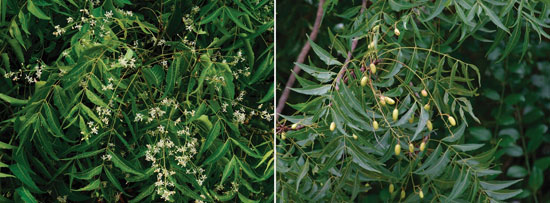Multi-faceted medicinal tree
View(s):In this series to mark Ruk Rakaganno’s 50th anniversary this year, Dr. Sriyanie Miththapala looks at some common trees
 In India, this is dubbed the ‘Tree of a Hundred Uses’ because of its multitude of uses in traditional medicine and in homes.
In India, this is dubbed the ‘Tree of a Hundred Uses’ because of its multitude of uses in traditional medicine and in homes.
In Sri Lanka, the juice from the leaves is used as a safe antiseptic for a range of diseases, including infectious diseases and skin ailments. Oil from the seeds is also used both internally and externally for various illnesses. Twigs were used, in the past, as toothbrushes. In agriculture, the leaves and seeds are used as a natural pesticide. The wood is valued because of its inherent insecticidal properties. The oil is used extensively in personal care products such as soaps, shampoos and toothpaste. The seed cake is an excellent fertiliser and the leaves are used as fodder.
In 1995, margosa or neem appeared in the news when it was discovered that the European Patent Office had granted a patent to a multinational pharmaceutical company – W. R. Grace – and the Department of Agriculture in the USA. This caused an uproar in India and the patent was challenged by the Indian government, which claimed that the process for which the patent had been granted had been used by Indians for over two millennia. The courts ruled in India’s favour.

This tree can be identified by its bright green feathery foliage, with leaflets that have serrated edges. Pix by (left) Vimukthi Weeratunga ; right, Gehan de Silva Wijeyeratne
The neem issue and others served as crucial catalysts to create global awareness about biopiracy. The Nagoya Protocol of the Convention on Biological Diversity was a direct result of this awareness and the new understanding that countries need to protect their genetic resources and traditional knowledge from biotheft.
This is a common tree of the dry and intermediate zones but is also found in the wet lowlands. It has a sparse crown of light green, characteristically feathery foliage. Leaves are divided once into lance-shaped leaflets, with serrated edges. The scented flowers are small and greenish-white, while the fruits are oval-shaped and small. It is native to the region.
Extracted from ‘What tree is that? The Ruk Rakaganno Layperson’s Guide to Some Trees of Sri Lanka’. Updated by the author using ‘Flowering plants commonly encountered in Sri Lankan habitats’ by Sriyanie Miththapala, Siril Wijesundara and Janaki Galappatti. (2011). National Trust: Colombo.
| Azadirachta indica Common/ English name: Margosa/Neem Family: Meliaceae (Sinhala name: Kohomba; Tamil name: Arulundi) | |
Searching for an ideal partner? Find your soul mate on Hitad.lk, Sri Lanka's favourite marriage proposals page. With Hitad.lk matrimonial advertisements you have access to thousands of ads from potential suitors who are looking for someone just like you.


